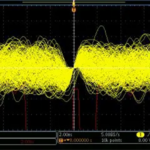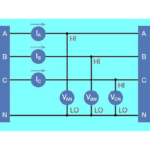Lines carrying symmetric signals, i.e. those with opposite polarities but with equal amplitudes on each line are commonly called balanced. But the correct term is differential signaling. While balanced lines and differential signaling may be used together, they are actually quite different.

One potentially confusing factor is that balanced lines generally take the from of twisted pairs–but twisted pairs are not necessarily balanced lines. Intentionally twisting individual data-carrying pairs greatly increases immunity to electromagnetic interference and crosstalk. The reasoning behind this mitigation technology is that twisting one or both conductors keeps them in close proximity to one another. Because electrical current in the two wires is going in opposite directions, they will create magnetic fields that are equal and opposite to each other. The result is a cancellation of EM radiation from the wire. Moreover, EM radiation coming from external sources will affect each wire equally due to their close proximity. The induced noise and crosstalk are common-mode signals that can be attenuated if not completely canceled through use of a differential receiver (or a transformer).
Another confusing bit: Balanced lines can be used with both differential amplifiers and with single-ended amplifiers. Differential signaling involves the two balanced-line conductors (with an optional shield) carrying the same signal at opposite polarity. More specifically, look at the voltage on each of the two lines and you will see two waveforms that are mirror images of each other. That is, when voltage on one line is at a maximum, voltage on the other line is at a minimum. The signals are not necessarily oscillating around zero; they can be at any voltage. The only requirement for understanding the effect is that the two are mirror images. Whatever is different between the two wires is what is amplified by the differential amplifier.
The same result can be obtained using single-ended amplifiers and balanced lines. Here the signal is often coupled into the balanced line and extracted at the other end via a transformer to ground, or via equivalent circuitry. The result is generally a somewhat more distorted signal than would be the case with differential amplifiers. But noise is rejected in both the differential amplifier and single-ended amplifier case.

When nearby pairs have equal twist rates (here we are talking about a conduit installation, metal or PVC), the proximity of different conductors within pairs remains constant, defeating the design goal. Here again a simple solution is available: altering the twist rate just a slight amount so as to disrupt the otherwise high degree of capacitive coupling.
A disadvantage in twisted pair because of different twist rates is that in video applications the varying amounts of skew will severely impact quality. Low-skew cable is a good solution.
Now consider single-ended signaling via a single conductor and ground instead of via a balanced line. Even if the signal and ground wires are twisted together, there can be common-mode noise. Moreover, any other noise (perhaps leaking in through the ground connection) will look like a signal to the receiver.





Leave a Reply
You must be logged in to post a comment.